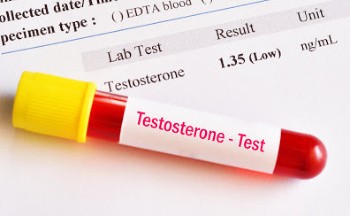
Testosterone Levels Have Fallen in Younger Men
Testosterone levels have been dropping among adolescent and young adult males in the United States, according to new research in the Journal of Sexual Medicine.
The findings are based on data from the National Health and Nutrition Examination Surveys (NHANES).
During the 1999-2000 survey cycle, the average testosterone measurement for men aged 15 to 39 was 605.39 ng/dL. By the 2015-2016 cycle, that number had dropped to 451.22 ng/dL.
Testosterone is on the Decline

In the United States, testosterone levels have declined in adolescent and young adult men since 1999, according to a recent study.
The hormone testosterone plays an important role in men’s health. (Women’s bodies also produce testosterone, but in much smaller amounts.) Testosterone gives a man his masculine traits, like facial hair and muscle mass. It contributes to bone health.
And it’s critical for sexual function and fertility. Libido, erections, and sperm production are largely driven by testosterone.
When does male Testosterone go down?
Around age 30, a man’s testosterone levels start to fall. It’s a natural part of getting older, and the process is gradual. Typically, a man may be diagnosed with testosterone deficiency if his levels fall below 300 ng/dL and he has symptoms like low sex drive, fatigue, and moodiness.
While younger men usually don’t need to worry about age-related testosterone declines, researchers have noted that almost 20% of adolescent and young adult men do have testosterone deficiency.
Researchers set out to learn more about the average testosterone levels for men in this age group. They worked with data from the National Health and Nutrition Examination Surveys (NHANES), a large-scale study of adults in the U.S. In particular, they looked at information for men aged 15 to 39 over 5 survey cycles between 1999 and 2016.
Testosterone levels – At a Glance
Overall, 4,045 men had their total testosterone levels measured during these time periods. The researchers reported the following averages:
NHANES Cycle | Average Testosterone Measurements |
1999-2000 | 605.39 ng/dL |
2003-2004 | 567.44 ng/dL |
2011-2012 | 424.96 ng/dL |
2013-2014 | 431.76 ng/dL |
2015-2016 | 451.22 ng/dL |
The researchers also noticed that men with a higher body mass index (BMI) were more likely to have lower testosterone levels. The men’s average BMI increased from 25.83 in the 1999-2000 cycle to 27.96 in the 2015-2016 cycle. (Average BMI ranges from 18.5 to 24.9. People with a BMI of 25 to 29.9 are considered overweight. Obese people have a BMI of 30 or higher.)
However, even for men with normal BMI, average testosterone levels dropped from 664.79 ng/dL in the 1999-2000 cycle to 529.24 ng/dL in the 2015-2016 cycle.
The results “may have large ramifications as low testosterone has been linked to underlying comorbidities and potentially increased mortality risk,” the study authors explained.
The findings were presented in October 2019 at the 20th Annual Fall Scientific Meeting of the Sexual Medicine Society of North America (SMSNA), held in Nashville, Tennessee.
Medical Resources
Resources
Centers for Disease Control and Prevention
“Defining Adult Overweight and Obesity”
(Page last reviewed: April 11, 2017)
https://www.cdc.gov/obesity/adult/defining.html
Medical News Today
Sissons, Claire
“Typical testosterone levels in males and females”
(September 17, 2018)
https://www.medicalnewstoday.com/articles/323085
The Journal of Sexual Medicine
Patel, P., et al.
“Trends in Serum Testosterone Levels Among Adolescent and Young Adult Men in the United States”
(Abstract. Published: January 2020, Volume 17, Issue 1, Supplement 1, Pages S3–S4)
https://www.jsm.jsexmed.org/article/S1743-6095(19)31529-2/fulltext
WebMD
McMillen, Matt
“Low Testosterone: How Do You Know When Levels Are Too Low?”
(August 31, 2016)

